A key element in keeping your rental property investment in excellent condition is knowing the current state it is in at any given time. It's standard practice with Atlanta homes for rent to do a thorough inspection of the property before and after a renter's tenure there, and doing so can be part of your standard practice. Attention to detail and complete documentation in the property inspection makes negotiating any payments for damages easier to accomplish, saving you time and money in the long run.
Make a Move-In Inspection
While you personally know that the property is up to your standards when you hand the keys to the new renter, this inspection is important for what it means in the future. By taking pictures, noting any small blemishes or anything that isn't functional, you create a log that helps you disclose the state of the property to the renter and hold them accountable for any issues that arise while they are living there. When your potential tenant looks through the property and agrees to rent it as-is, they are acknowledging whatever you've disclosed and taken responsibility for not damaging it themselves beyond reasonable wear and tear.
The more thorough you are, the easier it is to establish that major damage or a missing element of the property, like window screens or other items, was present when a tenant moved in. You want to avoid as much disputed damage as possible since those circumstances can create friction between you and renters, with whom you ideally want to maintain a positive relationship.
We'll discuss more on wear and tear versus damages in the move-out inspection!
Consider Mid-Lease Inspections
When renting out Atlanta homes, consider requiring a mid-lease inspection. These can be conducted, for instance, every six months, with full knowledge of the renter and plenty of advance notice. The goal of a mid-lease inspection is not to intrude on a renter's privacy but to ensure that the necessary upkeep of the building is being maintained.
In this inspection, the goal isn't to find every tiny smudge on a wall or small stain on a carpet, but rather to find out if major issues are occurring, from pet violations to a very major lack of cleanliness that could impact the property permanently. You can also let the renter know that this is your opportunity to make sure that there are no issues with property maintenance, such as damage to the building itself from the weather. Handling problems with the structure early on can save you a lot of money compared to only checking yearly.
One excellent factor of having mid-lease inspections is that they may do more from a prevention standpoint than from anything else; advertising ahead of time that you'll be having these inspections can encourage residents to keep the property in better condition because they know you'll be checking on it well before they move out.
Use a Move-Out Inspection to Have a Conversation About Damages
The move-out inspection is where you'll assess whether the damages/changes the renter has made to the property are more than 'normal wear and tear.' This term is used to point out that your renter isn't responsible for leaving the property better than they found it. It's understandable that a property will have some superficial damage simply because someone is living there, and the building is continuously aging.
Many of these elements are nearly unavoidable: fading paint or carpets, small scuffs on walls or floors, worn tile or grout in the bathroom, doors that stick, or even clogging in drains are all elements that you can work to avoid and still have some noticeable wear.
If neglected cleaning has created permanent problems, such as large, sticky stains left on the carpet, you will be able to document that these are above-and-beyond wear and tear. Showing your renter where their actions are causing needed repairs will help to explain any money you have to take from their security deposit to complete those repairs.
One valuable strategy can be to give tenants the opportunity to clean up or fix items themselves, if they want to do so, rather than having those repairs taken out of the deposit. By showing them what you expect upon final move-out, they have the choice to make the repairs correctly or expect you to deduct those repairs from their security deposit refund.
For more on property management best practices, check out these blogs.
Have an Expert Property Manager Help You Conduct Property Inspections
Inspections can be challenging if you've not done many of them - a property that looks like it is in pristine condition might have subtle issues that really need documentation to avoid disputes with renters in the future. Your Atlanta homes for rent will be in good hands if you work with a professional property manager because we've done so many property inspections that we know what to look for. How to document damage, and how to communicate professionally with renters. Get in touch with us today!



